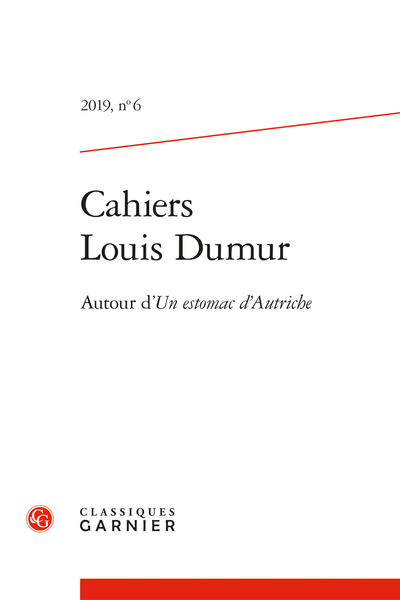
Résumés
- Type de publication : Article de revue
- Revue : Cahiers Louis Dumur
2019, n° 6. Autour d'Un estomac d'Autriche - Pages : 157 à 159
- Revue : Cahiers Louis Dumur
- Thème CLIL : 4027 -- SCIENCES HUMAINES ET SOCIALES, LETTRES -- Lettres et Sciences du langage -- Lettres -- Etudes littéraires générales et thématiques
- EAN : 9782406099635
- ISBN : 978-2-406-09963-5
- ISSN : 2427-8084
- DOI : 10.15122/isbn.978-2-406-09963-5.p.0157
- Éditeur : Classiques Garnier
- Mise en ligne : 20/01/2020
- Périodicité : Annuelle
- Langue : Français
rÉsumÉs/abstracts
Nicolas Gex, « Un curieux roman, Un estomac d’Autriche »
L’étude de la genèse d’Un estomac d’Autriche et des circonstances de sa publication nous renseigne sur les intentions de Dumur et sur les réactions suscitées par ses différentes prises de position. L’attitude des Genevois de 1814 face aux Autrichiens, les réserves suscitées par une possible adhésion à la Suisse ou l’attitude de Genève face à la France sont ainsi autant d’indicateurs d’un état d’esprit dont Dumur évalue sans concession la pertinence historique.
Mots-clés : Restauration, Genève, 1814, confédération helvétique, Napoléon.
Nicolas Gex, “A curious novel, Un estomac d’Autriche”
Studying the genesis of Un estomac d’Autriche and the circumstances surrounding its publication informs us about Dumur’s intentions and the reactions elicited by the various positions he took. In 1814, the attitudes of Genevans vis-à-vis Austrians, reservations about possibly joining Switzerland, or Geneva’s attitude toward France are so many indicators of a state of mind whose historical relevance Dumur evaluates uncompromisingly.
Keywords: Restoration, Geneva, 1814, Swiss Confederation, Napoleon.
Jean-Jacques Langendorf, « Les Autrichiens à Genève (30 décembre 1813 – 17 mai 1814) »
L’évocation des circonstances historiques précises de l’entrée des Autrichiens à Genève permet de donner un nouveau relief à quelques-unes des figures maîtresses de cette période, à commencer par celle du général comte Bubna, apprécié de Napoléon et qui montre, outre une maîtrise attendue des événements purement militaires, un appréciable savoir-faire diplomatique.
Mots-clés : Bubna, Rovéréa, Alexandre Ier, 1814, Leipzig.
158Jean-Jacques Langendorf, “Austrians in Geneva (December 30, 1813–May 17, 1814)”
Evoking the precise historical circumstances surrounding the entry of the Austrians into Geneva allows us to gain a better understanding of the leading figures of this period, starting with General Count Bubna, favored by Napoleon, who demonstrates significant diplomatic know-how in addition to the expected mastery of purely military affairs.
Keywords: Bubna, Rovéréa, Alexander I, 1814, Leipzig.
François Jacob, « Un estomac d’Autriche. Louis Dumur lecteur de Théodore Aubert »
Le « roman historique genevois » de Théodore Aubert, 1814, et le roman de Dumur n’ont apparemment pas grand-chose en commun. Plusieurs éléments de structure émergent cependant et nous invitent à reconsidérer les sources historiques auxquelles ont puisé les deux hommes en même temps que les canons littéraires auxquels ils se sont soumis.
Mots-clés : Théodore Aubert, trilogie genevoise, enfance, narrateur, Genève.
François Jacob, “Un estomac d’Autriche. Louis Dumur, reader of Théodore Aubert”
Théodore Aubert’s “historical Genevan novel,” 1814, and Dumur’s novel do not seem to have much in common. Several structural elements emerge, however, which invite us to reconsider the historical sources the two men drew from along with the literary canons they submitted to.
Keywords: Théodore Aubert, Geneva trilogy, childhood, narrator, Geneva.
Isaac Genoud, « Les couleurs de la guerre. L’uniforme militaire dans Un estomac d’Autriche »
Un estomac d’Autriche est, dit-on, un roman « coloré ». L’extrême précision avec laquelle Dumur décrit les uniformes français et alliés concourt à cette impression. On remarque pour autant, en consultant les archives de l’écrivain, quelques différences notables dans le traitement romanesque du costume militaire, les évocations littéraires de la période étant parfois préférées par Dumur aux chroniques historiques ou aux fresques iconographiques, pourtant abondantes, dont il dispose.
Mots-clés : uniforme, armée, Kaiserlicks, iconographie, roman historique.
159Isaac Genoud, “The colors of war. Military uniforms in Un estomac d’Autriche”
Un estomac d’Autriche has been described as a “colorful” novel. The extreme precision with which Dumur describes the French and allied uniforms contributes to this impression. We note, however, when consulting the archives of the writer, some remarkable differences in the fictional treatment of military costumes, the literary evocations of the period being sometimes preferred by Dumur over the chronicles or sweeping iconographic narratives, however abundant, that are available to him.
Keywords: uniform, Kaiserlicks, iconography, historical novel.
Nicolas Morel, « Quand “tout Genève festoyait les ‘libérateurs’”. La Restauration selon Louis Dumur »
La tonalité d’Un estomac d’Autriche participe sans doute moins du sérieux historique que du grotesque. C’est en effet à l’esprit carnavalesque que décrira Mikhail Bakhtine quelques décennies plus tard qu’il convient de rattacher l’atmosphère du roman. La table à laquelle Dumur invite son lecteur – au temps bienvenu d’une restauration à double sens – a, de toute évidence, des accents rabelaisiens.
Mots-clés : Mikhail Bakhtine, Rabelais, grotesque, carnavalesque, excès.
Nicolas Morel, “When ‘All of Geneva feted the ‘liberators’’. The Restoration according to Louis Dumur”
The tone of Un estomac d’Autriche undoubtedly has less to do with historical seriousness than with the grotesque. The atmosphere of the novel must be related to the carnivalesque spirit that Mikhail Bakhtin described a few decades later. The table to which Dumur invites his reader–at the welcome time of a restauration in two senses of the word–obviously has shades of Rabelais.
Keywords: Mikhail Bakhtin, Rabelais, grotesque, carnivalesque, excess.